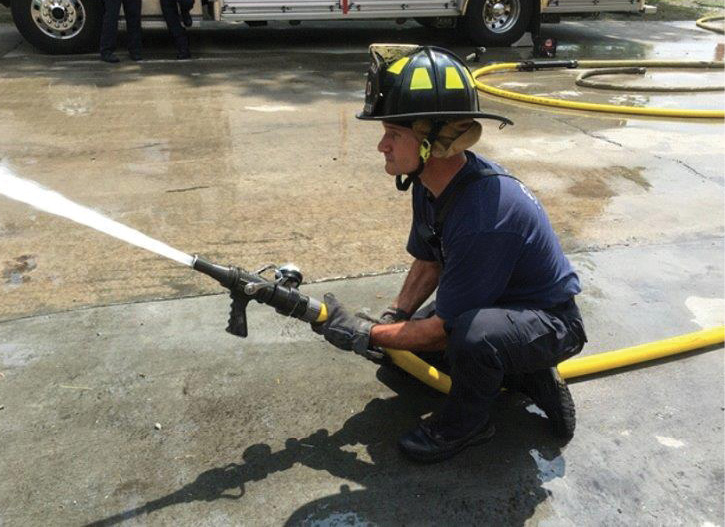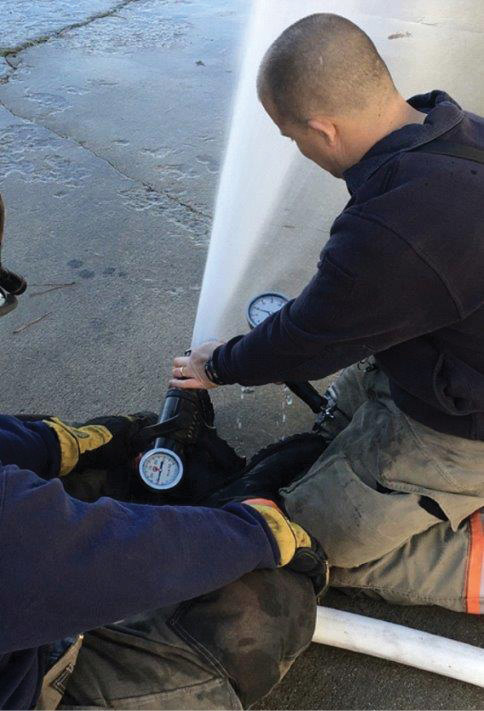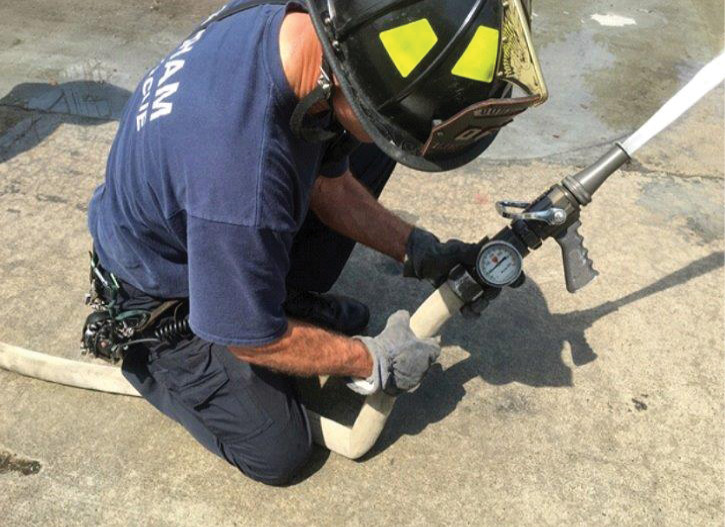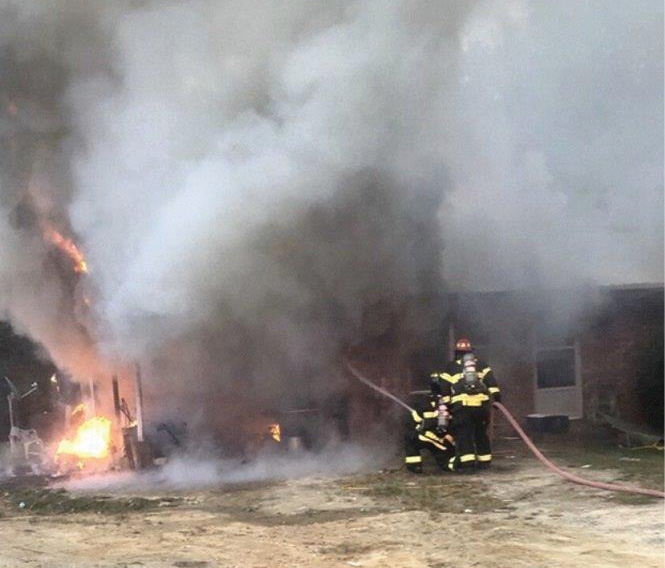
VOLUNTEERS CORNER ❘ By RICHARD RAY
For fireground operations in a rural setting, the first challenge that comes to mind for most firefighters is water availability and the ability to establish a positive water supply. Although this can be the most difficult task for the rural engine company, there typically are additional challenges including advanced fire on arrival, access to the structure, setbacks with long driveways, staffing, and equipment (to name a few). However, water is the critical element that will largely determine rural fireground success.
The key attributes that help rural engine company firefighters win on the fireground are the apparatus, the pump, the hose and nozzle package, and the water supply. These elements, along with an aggressive fire attack, help firefighters solve almost any fire problem they encounter on a rural fireground. Additionally, standard operating procedures (SOPs) provide the framework for how the firefighters and engine will operate. Through training, these items are brought together, practiced, and then executed on the fireground when the time comes. The ultimate winner is the citizen.
RELATED
Truck Company Work in the Rural Environment
Rural Connections: Water Supply
Rural Connections: The Importance of Training

(1) Firefighters should flow test their equipment to ensure they know exactly what they are flowing with their pump, hose, and nozzles. (Photos by author unless otherwise noted.)
Fireground Flow
The starting point with fireground flow is determining your target flow for the 1¾- and 2½-inch hose. The benchmarks for these two lines are 150 and 250 gallons per minute (gpm), respectively; for departments that use two-inch hose, your target flow should be 210 gpm. Some factors that determine target flow are the number of available firefighters, district needs, how the flow will be achieved (i.e., hose and nozzles), and the pump.
To know if you are achieving the desired flow, you must do flow testing. This can prove to be a challenge for a lot of rural fire departments. Most rural/volunteer departments do not have a flowmeter and the necessary gauges to accurately determine what they are flowing. Because of budget constraints, most departments can’t purchase new nozzles and hose at the same time. So, the department will buy one or the other in hopes of having both within a close time frame. The mismatch of hose and nozzles can lead to “nozzle whip,” more kinks, or not achieving the desired flow. It is important for the department to view the hose, nozzles, and pump as a total package with the understanding that flow testing the total package will give the rural engine company the most accurate flow of the equipment.
The hose is a huge factor in fireground flow. I have flow tested hose that has had as much as a 10-gpm difference in different 50-foot hose sections. When looking at the hose used by a rural engine company—specifically the 1¾-inch—is it constructed for 50-, 75-, or 100-pound-per-square-inch (psi) nozzles? How old is the hose? What is the friction loss per 100 feet? These key factors help rural engine company firefighters better understand flow and how the hose behaves. When it comes to choosing hose, how it is constructed and manufactured really does make a difference. Firefighters should educate themselves on hose construction and performance.
Nozzle selection is the next critical component for fireground flow. The debate between fog and smooth bore nozzles will always be a hot topic, but understanding the difference between the two and how they perform allows firefighters to make an informed decision on which nozzle is needed for a particular application.
Nozzle manufacturers make a wide array of nozzles. What types are currently on your engine? When was the last time the nozzles on your engine were flow tested? If you carry fog nozzles—specifically older ones—are they performing as desired? Have they been maintained over the years? If it is a fog nozzle, the preferred type should be the constant gallonage nozzle.
Be wary of automatic nozzles and select gallonage nozzles. In my experience, the nozzles didn’t perform as well as the constant gallonage. Today, fog nozzles are manufactured with nozzle pressures of 50, 75, or 100 psi. The 50- and 75-psi nozzles have become popular because the lower nozzle pressures have less nozzle reaction and are easier for the firefighter to use. However, this may not always be the case. So, it is best to measure nozzle reaction as part of your flow testing.
If the smooth bore nozzle is your preference, understand and flow test it as well. Whether it is 1¾- or 2½-inch hose, the nozzle pressure can be 40, 50, or 60 psi; the gpm are determined by tip size and nozzle pressure. For 1¾-inch hose, use a 7⁄8- or 15⁄16-inch tip. Matching tip size and hose diameter is critical in achieving a manageable hoseline with the desired flow. The smooth bore nozzle affords firefighters larger drops of water on the fire with greater penetration, especially when faced with an advanced fire situation, which is common in rural areas. When dealing with an advanced fire condition, the heat can easily absorb the fog nozzle’s stream, which in turn gives minimal extinguishment, especially if a firefighter chooses the wrong size hoseline.


It is important for rural engine companies to use hose and nozzles that match. (2) This firefighter is battling a hose and nozzle combination that does not match. (3) This firefighter is managing a hose and nozzle combination that matches.
When using the 2½-inch hose with a smooth bore nozzle, the 13⁄16-inch tip is a great tip selection. At a nozzle pressure of 40 psi, the flow is 265 gpm; at 50 psi, the flow is 300 gpm; and at 60 psi, the flow is 325 gpm. This gives the firefighters some options when encountering advanced or heavy fire conditions.
One point to remember when flowing the 2½-inch line is that less is more. This concept allows for a more manageable 2½-inch line with a flow that exceeds its expected target flow. This makes the 13⁄16-inch tip such a great tip.
It is beneficial if rural engine companies have an option for situations that warrant larger streams. One great option is a portable monitor that flows 500 gpm. Rural engine companies can get a quick knock on advanced fire conditions and then reduce down to smaller handlines right off the end of the monitor. These are much quicker to deploy, especially when they are preconnected, rather than having to remove the deluge gun from the top of the truck. Grab the base out of a compartment and then stretch the necessary hose to supply it.
Once you have flowed and tested your hose, nozzles, and pumps, your firefighters will start to understand their capabilities. However, this is where water supply comes into play.
How do we supply these desired flows? Where will the water come from? In a rural setting, the vast majority of fire attacks begin on apparatus tank water. Obviously, how long the firefighters can flow and operate lines on tank water is directly related to the amount of water that the truck will carry. Depending on where you are in the United States, rural engines carry a range from as little as 750 gallons to as much as 3,000 gallons of water. So, operational time frames will be based on tank water.

(4) In a rural setting, initial companies will be operating on their own. Hoseline position is extremely critical. Here, the engine crew was able to get a quick knock on this fire in a carport and then reposition the hoseline to the interior. (Photo by Clark McVey.)
In my volunteer department, we ran a pumper/tanker that carried 1,500 gallons. This gave us many options and allowed us to establish an aggressive fire attack.
Think about the tank size that’s on your rural engine company. Do you know how long you can flow your target flows on tank water? What is your operational time frame? You would be surprised at how long you can flow on tank water. Rural engine companies should use tank-level gauges only as a guide—not a determinant—on how much water they have flowed. Too many times, pump operators will indicate that they are out of water based on what the tank level lights are indicating. In reality, they may not be out of water. Again, the mindset should be to overwhelm the fire with the available water.
Where does the sustained water supply come from for the rural engine company? If hydrants are present, they are usually long distances apart. Depending on what part of the United States you are in, tankers/tenders are used. The two options are drop-tank and nurse-feeding operations. Ultimately, fire volume and structure will determine which is the best option. For small fires, if all the tank water is used up, a nurse-feeding operation is usually the right choice. It is usually for one- or maybe two-line fires. For larger fires, the drop-tank operation is preferred. These are fires where 2½-inch hose or larger streams are put into operation. A huge key to being successful with a water supply lies within your SOPs, which should identify how you will establish and set up the water supply and resources that will sustain the positive water supply.
Training is critical to establishing and sustaining the water supply in a rural setting. This is an area where the suburban engine company can get into trouble. This is a result of always using hydrants and having them close by. In today’s fire service, mutual-aid agreements and contracts are bringing more suburban firefighters into the rural setting. There is a good chance the suburban engine company will be tasked with securing a water supply. So, training should be frequent, realistic, repetitive, and not always done in a parking lot.
All of the above information is great. Knowing exactly what your engine will flow with different lines and how long the engine can operate on tank water is extremely critical information that rural engine companies must know. However, I would be remiss if I didn’t discuss the most important aspect of knowing all this data. Hoseline position and size is the last part of water delivery that ultimately allows a department to win or lose on the rural fireground. As mentioned earlier, structure fires in rural areas tend to be advanced on arrival of the fire department. Advanced fire conditions coupled with difficult stretches, limited access, or minimal personnel can result in improper hose positioning, which creates a huge challenge in getting good water on the fire. This is when the engine company plays catch-up, increasing the workload and effort needed to stop the fire’s forward progression. Many times, there are limited personnel early in the incident, and firefighters choose the easiest option rather than what the fire needs; this applies to positioning, size, and flow. If the engine company understands its capabilities and limitations with equipment and personnel, it can achieve fireground success because the firefighters understand their jobs and the actions that need to happen.
Rural engine company operations are equally as challenging as engine company operations in the urban and suburban environments. A fundamental understanding of water delivery is the cornerstone of the engine company in any setting. Although the rural setting is challenging because of the limited availability of water, water application in the right amount, at the right time, and in the right place saves lives and property.
Overwhelming the fire with water is and always will be the solution to the problem. Through training, knowledge, and effort, rural engine company firefighters can make informed and accurate decisions that produce a winning fireground for firefighters and citizens.
RICHARD RAY is a 27-year fire service veteran who has worked in volunteer and career departments. He is a captain and an adjunct training officer with the Creedmoor (NC) Volunteer Fire Department. He is also a battalion chief with the Durham (NC) Fire Department as well as an adjunct instructor with its training division. He has presented at FDIC International and has written for Fire Engineering.
Originally ran in Volume 172, Issue 5.

